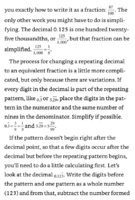HazeTheBeater
New member
- Joined
- Jan 6, 2020
- Messages
- 4
Hey everyone! Thanks a lot for the past help in my other post.
Right now I am studying arithmetics with a McGrawHill book, and they seem to have a lot of get-arounds for all the types of decimals that exist.
They have 3 different ways to convert decimals and for different exceptions. I believe this is inefficient and most likely troublesome to remember because
you gotta go like : If this is this, then that, or if it is that, then this and that.
Thats a lot of trouble for me, does anyone know of a way to do this without too much hassle that includes a way for bar notation decimals, normal decimals and 0.00 decimals?
Right now I am studying arithmetics with a McGrawHill book, and they seem to have a lot of get-arounds for all the types of decimals that exist.
They have 3 different ways to convert decimals and for different exceptions. I believe this is inefficient and most likely troublesome to remember because
you gotta go like : If this is this, then that, or if it is that, then this and that.
Thats a lot of trouble for me, does anyone know of a way to do this without too much hassle that includes a way for bar notation decimals, normal decimals and 0.00 decimals?






